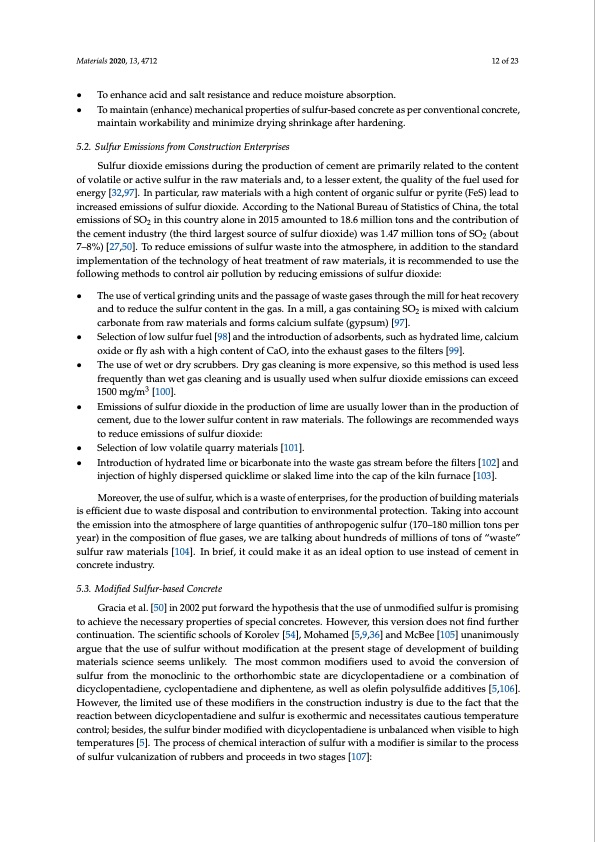
PDF Publication Title:
Text from PDF Page: 012
Materials 2020, 13, 4712 12 of 23 • To enhance acid and salt resistance and reduce moisture absorption. • To maintain (enhance) mechanical properties of sulfur-based concrete as per conventional concrete, maintain workability and minimize drying shrinkage after hardening. 5.2. Sulfur Emissions from Construction Enterprises Sulfur dioxide emissions during the production of cement are primarily related to the content of volatile or active sulfur in the raw materials and, to a lesser extent, the quality of the fuel used for energy [32,97]. In particular, raw materials with a high content of organic sulfur or pyrite (FeS) lead to increased emissions of sulfur dioxide. According to the National Bureau of Statistics of China, the total emissions of SO2 in this country alone in 2015 amounted to 18.6 million tons and the contribution of the cement industry (the third largest source of sulfur dioxide) was 1.47 million tons of SO2 (about 7–8%) [27,50]. To reduce emissions of sulfur waste into the atmosphere, in addition to the standard implementation of the technology of heat treatment of raw materials, it is recommended to use the following methods to control air pollution by reducing emissions of sulfur dioxide: • The use of vertical grinding units and the passage of waste gases through the mill for heat recovery and to reduce the sulfur content in the gas. In a mill, a gas containing SO2 is mixed with calcium carbonate from raw materials and forms calcium sulfate (gypsum) [97]. • Selection of low sulfur fuel [98] and the introduction of adsorbents, such as hydrated lime, calcium oxide or fly ash with a high content of CaO, into the exhaust gases to the filters [99]. • The use of wet or dry scrubbers. Dry gas cleaning is more expensive, so this method is used less frequently than wet gas cleaning and is usually used when sulfur dioxide emissions can exceed 1500 mg/m3 [100]. • Emissions of sulfur dioxide in the production of lime are usually lower than in the production of cement, due to the lower sulfur content in raw materials. The followings are recommended ways to reduce emissions of sulfur dioxide: • Selection of low volatile quarry materials [101]. • Introduction of hydrated lime or bicarbonate into the waste gas stream before the filters [102] and injection of highly dispersed quicklime or slaked lime into the cap of the kiln furnace [103]. Moreover, the use of sulfur, which is a waste of enterprises, for the production of building materials is efficient due to waste disposal and contribution to environmental protection. Taking into account the emission into the atmosphere of large quantities of anthropogenic sulfur (170–180 million tons per year) in the composition of flue gases, we are talking about hundreds of millions of tons of “waste” sulfur raw materials [104]. In brief, it could make it as an ideal option to use instead of cement in concrete industry. 5.3. Modified Sulfur-based Concrete Gracia et al. [50] in 2002 put forward the hypothesis that the use of unmodified sulfur is promising to achieve the necessary properties of special concretes. However, this version does not find further continuation. The scientific schools of Korolev [54], Mohamed [5,9,36] and McBee [105] unanimously argue that the use of sulfur without modification at the present stage of development of building materials science seems unlikely. The most common modifiers used to avoid the conversion of sulfur from the monoclinic to the orthorhombic state are dicyclopentadiene or a combination of dicyclopentadiene, cyclopentadiene and diphentene, as well as olefin polysulfide additives [5,106]. However, the limited use of these modifiers in the construction industry is due to the fact that the reaction between dicyclopentadiene and sulfur is exothermic and necessitates cautious temperature control; besides, the sulfur binder modified with dicyclopentadiene is unbalanced when visible to high temperatures [5]. The process of chemical interaction of sulfur with a modifier is similar to the process of sulfur vulcanization of rubbers and proceeds in two stages [107]:PDF Image | Critical Review on the Properties and Applications of Sulfur-Based Concrete

PDF Search Title:
Critical Review on the Properties and Applications of Sulfur-Based ConcreteOriginal File Name Searched:
materials-13-04712.pdfDIY PDF Search: Google It | Yahoo | Bing
Sulfur Deposition on Carbon Nanofibers using Supercritical CO2 Sulfur Deposition on Carbon Nanofibers using Supercritical CO2. Gamma sulfur also known as mother of pearl sulfur and nacreous sulfur... More Info
CO2 Organic Rankine Cycle Experimenter Platform The supercritical CO2 phase change system is both a heat pump and organic rankine cycle which can be used for those purposes and as a supercritical extractor for advanced subcritical and supercritical extraction technology. Uses include producing nanoparticles, precious metal CO2 extraction, lithium battery recycling, and other applications... More Info
| CONTACT TEL: 608-238-6001 Email: greg@infinityturbine.com | RSS | AMP |